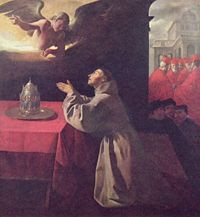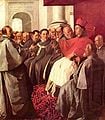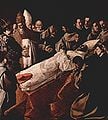Difference between revisions of "Bonaventura" - New World Encyclopedia
Keisuke Noda (talk | contribs) (imported from wiki) |
Keisuke Noda (talk | contribs) m |
||
| Line 79: | Line 79: | ||
[[Category:Saints]] | [[Category:Saints]] | ||
[[Category:Franciscans]] | [[Category:Franciscans]] | ||
| − | |||
| − | |||
[[Category:Doctors of the Church]] | [[Category:Doctors of the Church]] | ||
[[Category:Natives of Tuscany]] | [[Category:Natives of Tuscany]] | ||
[[Category:Roman Catholic theologians|Bonaventure]] | [[Category:Roman Catholic theologians|Bonaventure]] | ||
[[Category:Theologians|Bonaventure]] | [[Category:Theologians|Bonaventure]] | ||
| − | + | [[Category:Philosophy and religion]] | |
| − | [[ | ||
| − | |||
| − | |||
| − | |||
| − | |||
| − | |||
| − | |||
| − | |||
| − | |||
| − | |||
| − | |||
| − | |||
| − | |||
| − | |||
| − | |||
| − | |||
| − | |||
{{Credit|61789777}} | {{Credit|61789777}} | ||
Revision as of 00:35, 17 July 2006
- For other uses, see Bonaventure (disambiguation).
| Saint Bonaventure | |
|---|---|
| the Devout Doctor | |
| Born | 1221, Bagnoregio, Italy |
| Died | July 15,1274 Lyon, France |
| Venerated in | Roman Catholic Church |
| Canonized | April 14,1482 |
| Feast | July 15 |
| Attributes | cardinal's hat; ciborium; Holy Communion; cardinal in Franciscan robes, usually reading or writing |
| Patronage | bowel problems |
| A short hymn or prayer Pierce, O most sweet Lord Jesus, my inmost soul with the most joyous and healthful wound of Thy love, and with true, calm and most holy apostolic charity, that my soul may ever languish and melt with entire love and longing for Thee, may yearn for Thee and for thy courts, may long to be dissolved and to be with Thee. Grant that my soul may hunger after Thee, the Bread of Angels, the refreshment of holy souls, our daily and supersubstantial bread, having all sweetness and savor and every delightful taste. May my heart ever hunger after and feed upon Thee, Whom the angels desire to look upon, and may my inmost soul be filled with the sweetness of Thy savor; may it ever thirst for Thee, the fountain of life, the fountain of widsom and knowledge, the fountain of eternal light, the torrent of pleasure, the fulness of the house of God; may it ever compass Thee, seek Thee, find Thee, run to Thee, come up to Thee, meditate on Thee, speak of Thee, and do all for the praise and glory of Thy name, with humility and discretion, with love and delight, with ease and affection, with perseverence to the end; and be Thou alone ever my hope, my entire confidence, my riches, my delight, my pleasure, my joy, my rest and tranquility, my peace, my sweetness, my food, my refreshment, my refuge, my help, my wisdom, my portion, my possession, my treasure; in Whom may my mind and my heart be ever fixed and firm and rooted immovably. Amen.
| |
Saint Bonaventura (born Giovanni di Fidanza) (1221 – July 15, 1274), was a Franciscan theologian.
Early life
He was born at Bagnoregio in Latium, not far from Viterbo. He is said to have received his cognomen of Bonaventura when he was cured from a serious childhood illness through the intercession of St Francis of Assisi. He entered the Franciscan order in 1243, and studied at Paris possibly under Alexander of Hales, and certainly under Alexander's successor, John of Rochelle, to whose chair he succeeded in 1253.
Three years earlier his fame had gained for him to Lector on the Sentences, and in 1255 he received the degree of master, the medieval equivalent of doctor. In the year after having successfully defended his order against the reproaches of the anti-mendicant party, he was elected general of his order. It was by his order that Roger Bacon, a Franciscan Friar himself, was interdicted from lecturing at Oxford, and compelled to put himself under the surveillance of the order at Paris. He was instrumental in procuring the election of Gregory X, who rewarded him with the titles of cardinal and bishop of Albano, and insisted on his presence at the great Council of Lyon in the year 1274. There after, his significant contributions led to a union of the Greek and Latin Churches, he died. The only extant relic of the Saint is the arm and hand with which he wrote his great Commentary on the Four Books of Peter Lombard, which arm is now conserved at Bagnoregio, in the parish Church of St. Nicholas.
Philosophy & Works
Bonaventura's character seems not unworthy of the eulogistic title, "Doctor Seraphicus," bestowed on him by his contemporaries, and of the place assigned to him by Dante in his Paradiso. He was formally canonized in 1482 by the Conventual Franciscan Sixtus IV, and ranked along with St. Thomas Aquinas as the greatest doctors of the church by the Conventual Franciscan, Sixtus V, in 1587. His works, as arranged in the most recent Critical Edition of his works, by the Quaracchi Fathers (Collegio S. Bonaventura) consist of a Commentary on the Sentences of Lombard, in 4 volumes, and 8 other volumes, among which are a Commentary on the Gospel of St. Luke and a number of smaller works; the most famous of which are Itinerarium Mentis ad Deum, Breviloquium, De Reductione Artium ad Theologiam, Soliloquium, and De septem itineribus aeternitatis, in which most of what is individual in his teaching is contained.
In philosophy Bonaventura presents a marked contrast to his contemporaries, Roger Bacon and Thomas Aquinas. While these may be taken as representing respectively physical science yet in its infancy, and Aristotelian scholasticism in its most perfect form, he brings before us the mystical and Platonizing mode of speculation. Which had already to some extent found expression in Hugo and Richard of St. Victor, and in Bernard of Clairvaux. To him the purely intellectual element, though never absent, is of inferior interest when compared with the living power of the affections or the heart. He used the authority of Aristotle in harmony with Scriptural and Patristic texts, and attributed much of the heretical tendency of the age to the attempt to divorce Aristotelian philosophy from Catholic Theology. Like St. Thomas Aquinas, with whom he shared numerous profound agreements in matters theological and philosophical, he combated the Aristotelian notion of the eternity of the world vigorously. But the Platonism he received was Plato as understood by St Augustine, and as he had been handed down by the Alexandrian school and the author of the mystical works passing under the name of Dionysius the Areopagite.
Bonaventura accepts as Platonic the theory that ideas do not exist in rerum natura, but as ideals exemplified by the Divine Being, according to which actual things were formed; and this conception has no slight influence upon his philosophy. Like all the great scholastic doctors he starts with the discussion of the relations between reason and faith. All the sciences are but the handmaids of theology; reason can discover some of the moral truths which form the groundwork of the Christian system, but others it can only receive and apprehend through divine illumination. In order to obtain this illumination, the soul must employ the proper means, which are prayer, the exercise of the virtues, whereby it is rendered fit to accept the divine light, and meditation which may rise even to ecstatic union with God. The supreme end of life is such union, union in contemplation or intellect and in intense absorbing love; but it cannot be entirely reached in this life, and remains as a hope for futurity. The mind in contemplating God has three distinct aspects, stages or grades—the senses, giving empirical knowledge of what is without and discerning the traces (vestigia) of the divine in the world; the reason, which examines the soul itself, the image of the divine Being; and lastly, pure intellect (intelligentia), which, in a transcendent act, grasps the Being of the divine cause.
To these three correspond the three kinds of theology-theologia symbolica, theologia propria and theologia mystica. Each stage is subdivided, for in contemplating the outer world we may use the senses or the imagination; we may rise to a knowledge of God per vestigia or in vestigiis. In the first case the three great properties of physical bodies—weight, number, measure,—in the second the division of created things into the classes of those that have merely physical existence, those that have life, and those that have thought, irresistibly lead us to conclude the power, wisdom and goodness of the Triune God. So in the second stage we may ascend to the knowledge of God, per imaginem, by reason, or in imagine, by the pure understanding (intellectus); in the one case the triple division—memory, understanding and will,—in the other the Christian virtues—faith, hope and charity,—leading again to the conception of a Trinity of divine qualities—eternity, truth and goodness.
In the last stage we have first intelligentia, pure intellect, contemplating the essential being of God, and finding itself compelled by necessity of thought to hold absolute being as the first notion, for non-being cannot be conceived apart from being, of which it is but the privation. To this notion of absolute being, which is perfect and the greatest of all, objective existence must be ascribed. In its last and highest form of activity the mind rests in the contemplation of the infinite goodness of God, which is apprehended by means of the highest faculty, the apex mentis or synderesis. This spark of the divine illumination is common to all forms of mysticism, but Bonaventura adds to it peculiarly Christian elements. The complete yielding up of mind and heart to God is unattainable without divine grace, and nothing renders us so fit to receive this gift as the meditative and ascetic life of the cloister. The monastic life is the best means of grace.
Bonaventura, however, is not merely a meditative thinker, whose works may form good manuals of devotion; he is a dogmatic theologian of high rank, and on all the disputed questions of scholastic thought, such as universals, matter, the principle of individualism, or the intellectus agens, he gives weighty and well-reasoned decisions. He agrees with Albertus Magnus in regarding theology as a practical science; its truths, according to his view, are peculiarly adapted to influence the affections. He discusses very carefully the nature and meaning of the divine attributes; considers universals to be the ideal forms pre-existing in the divine mind according to which things were shaped; holds matter to be pure potentiality which receives individual being and determinateness from the formative power of God, acting according to the ideas; and finally maintains that the intellectus agens has no separate existence. On these and on many other points of scholastic philosophy the Seraphic Doctor exhibits a combination of subtlety and moderation, which makes his works particularly valuable.
Namesakes
Ventura, California and Ventura County, California are named for Saint Bonaventure, as is Bonaventure, Quebec.
St. Bonaventure University, the largest Franciscan university in the English-speaking world, is located in Western New York. St. Bonaventure's College is a private Roman Catholic school located in Newfoundland. And St. Bonaventure College and High School is located in Hong Kong. St. Bonaventure's Catholic Comprehensive School is located in Forest Gate, London.
ReferencesISBN links support NWE through referral fees
- This article incorporates text from the Encyclopædia Britannica Eleventh Edition, a publication now in the public domain.
External links
| Saints Portal |
| |||||
Credits
New World Encyclopedia writers and editors rewrote and completed the Wikipedia article in accordance with New World Encyclopedia standards. This article abides by terms of the Creative Commons CC-by-sa 3.0 License (CC-by-sa), which may be used and disseminated with proper attribution. Credit is due under the terms of this license that can reference both the New World Encyclopedia contributors and the selfless volunteer contributors of the Wikimedia Foundation. To cite this article click here for a list of acceptable citing formats.The history of earlier contributions by wikipedians is accessible to researchers here:
The history of this article since it was imported to New World Encyclopedia:
Note: Some restrictions may apply to use of individual images which are separately licensed.


